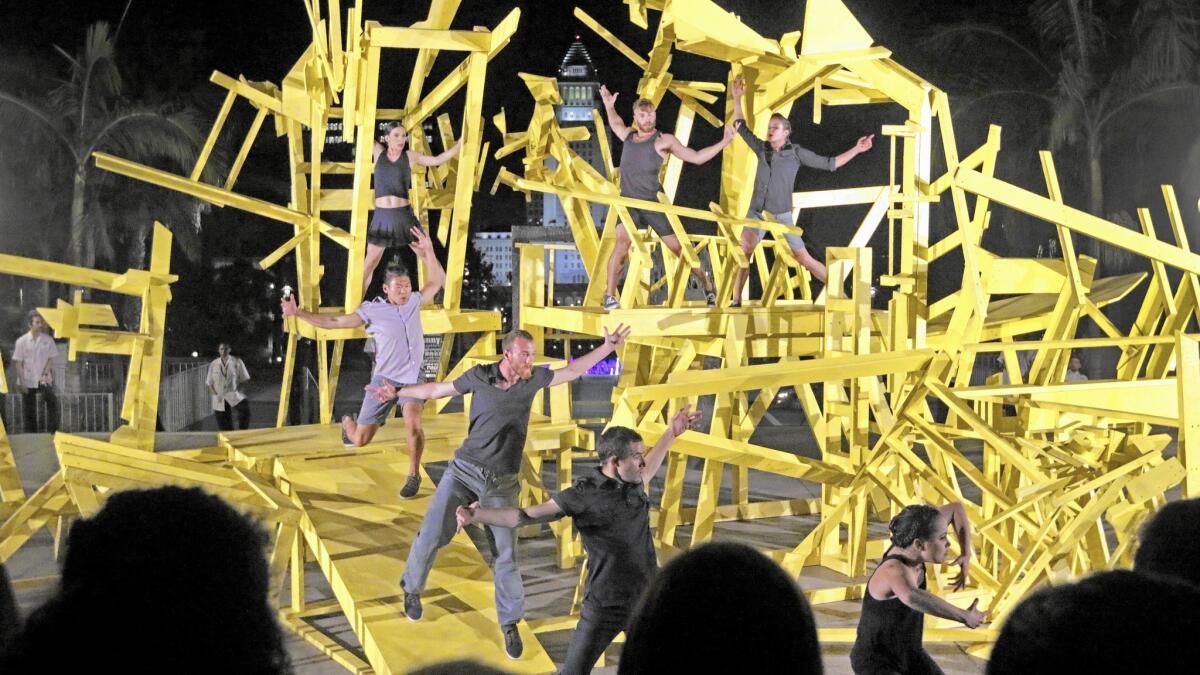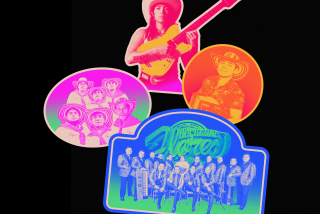Review: Moves After Dark program presents 4 female-led dance groups in unconventional spaces

Skyscrapers may be under construction in downtown Los Angeles, but it was dance that broke ground this week at the Music Center.
Usually a presenter of touring dance troupes, the Music Center made a point of featuring four local, female-led groups in its new Moves After Dark program Monday and Tuesday. Ate9, Lula Washington Dance Theatre, Bodytraffic and a group assembled by Ana María Alvarez performed original and reimagined choreography in unconventional spaces at the Music Center. The brainchild of Renae Williams Niles, the center’s departing vice president of programming, Moves After Dark aims to break down the barriers between architecture and contemporary dance.
On Monday night, all the elements were in place to do just that, as clusters of 50 to 100 audience members rotated among four site-specific works.
Alvarez’s “wade en el agua,” performed in the reflecting pool of the Mark Taper Forum, had the most liquid disposition, fluctuating from serene to frenetic. Former generations of Alvarez’s Contra-Tiempo dance troupe splashed, strutted and swung one another around. Sometimes flailing like toddlers at bath time, other times evoking priestesses at worship, the all-female ensemble was shaky in the shallows. One performer emitted deep vocalizations, washing the space with a spiritual serenity, while dancers dipped their hands into the pool, as if to wash away something more than dirt.
ESSENTIAL ARTS & CULTURE NEWSLETTER >> Get great stories delivered to your inbox
If Alvarez’s “wade en el agua” was a baptism by water, then Lula Washington Dance Theatre’s assault on the steps of Walt Disney Concert Hall was a trial by fire.
In the politically charged “Message for My Peeps,” choreographed by Tamica Washington-Miller, the company demonstrated an electric and fiery intensity, made even fiercer by the dancers’ fluent negotiation of the sweeping staircase of Disney Hall. Vaulting over railings, scrambling up stairs and pirouetting on balance-beam-thin steps, this company seemed as at home here as any parkour crew.
Inside the rarefied air of the Dorothy Chandler Pavilion’s Founders’ Room, Ate9 created a decadent affair with “Kelev Lavan.” Stepping into the wood-paneled room, rarely open to the public, I felt as if I had stumbled into a private after-party. Empty Champagne glasses, popcorn just past its prime and scattered playing cards suggested a night at its bitter end, but the festivities were just about to begin. Seven statuesque dancers perched in a regal tableau atop sofas and chaises, then launched into moves that seemed under the influence of something more potent than Champagne.
Their possession by some controlled substance was mere illusion. These bodies were well-oiled machines — finely tuned to tick, pulse and undulate under their own meticulous volition. Ate9 artistic director Danielle Agami assembled the vignettes, but each dancer asserted his or her authority over every absurd gesture. Some may have found the dancers’ eerie movements disconcerting, but that was part of Ate9’s intoxication.
From the upper reaches of the Music Center, we then moved back down to earth, where Bodytraffic, in “Restructure,” snaked and slithered through sculpture artist Gustavo Godoy’s yellow tangle of plywood spikes, ramps and ladders on the central plaza. A repeat from the 2014 Dance Camera West festival, the dance choreographed by Victor Quijada took center stage again as the Moves After Dark finale. Bodytraffic moved like a mesmerizing human jigsaw puzzle that unfolded to engrossing effect on a jungle gym built for adults.
This last segment of the evening concluded at the foot of the Robert Graham sculpture, “The Dance Door.” L.A. dance seemed to be knocking with a vengeance. It’s time to let her come inside.
More to Read
The biggest entertainment stories
Get our big stories about Hollywood, film, television, music, arts, culture and more right in your inbox as soon as they publish.
You may occasionally receive promotional content from the Los Angeles Times.










